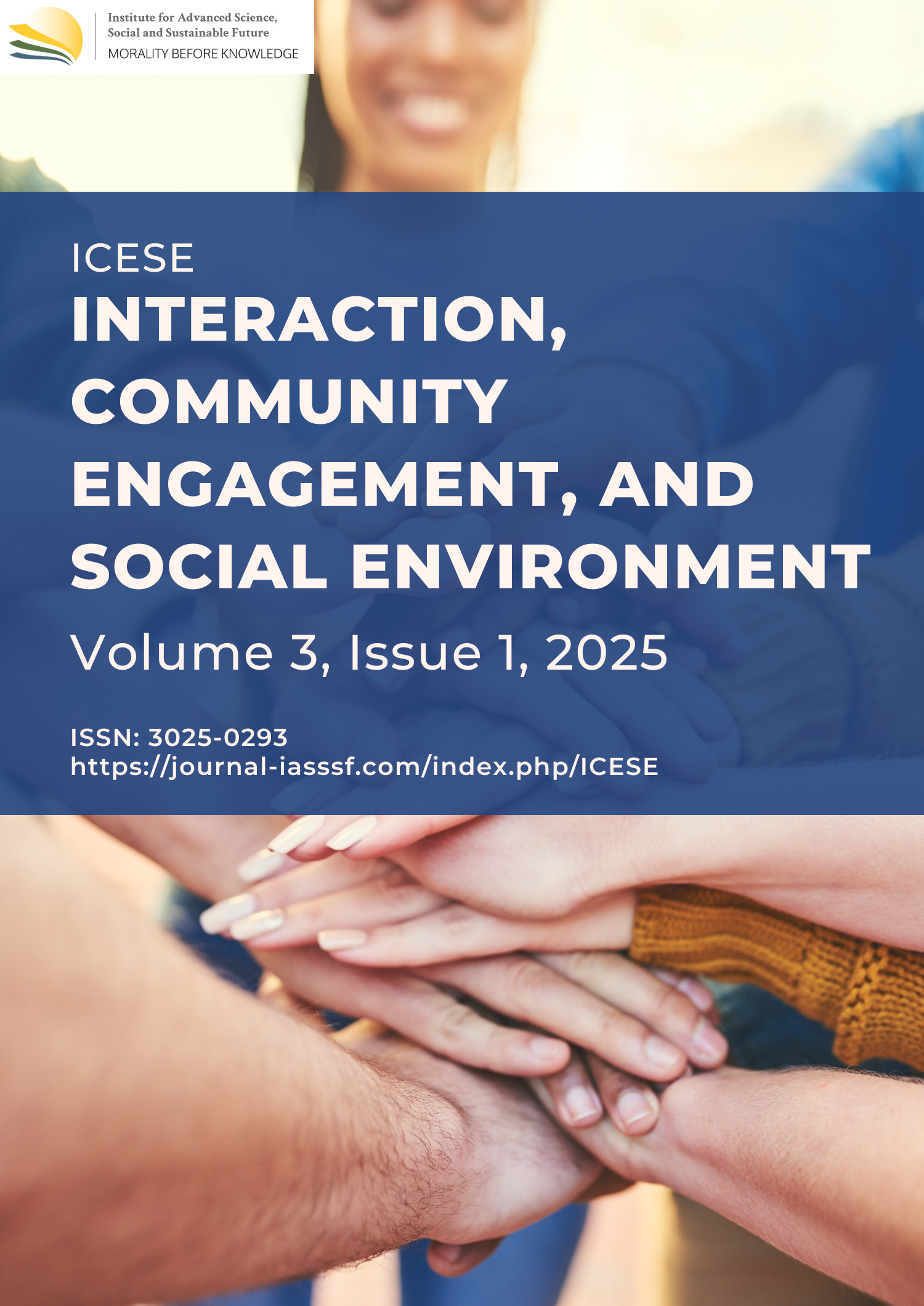The influence of the friendship factor on social media on the intention to continue social shopping and social media participation: A study on generation Z
DOI:
https://doi.org/10.61511/icese.v3i1.2025.2137Keywords:
friendship factor, social shopping, social media participation, expected confirmation model (ECM)Abstract
Background: Humans continue to revolutionize how they search for and process information in line with technological advancements, social changes, and evolving needs. However, amidst the openness of information, the friendship factor is often overlooked due to broad access to various sources without considering their credibility. This study aims to understand how the friendship factor, particularly informational social influence, interpersonal trust, and perceptions of a friend's knowledge, influences consumer behavior in the context of social shopping and social media participation. It also examines the role of confirmation and perceived usefulness in shaping consumer satisfaction and their impact on the intention to continue social shopping and social media participation, using an Expected Confirmation Model (ECM) adapted to consumer behavior. Method: This study employs a quantitative design with a single cross-sectional method and purposive sampling. Data were collected through a structured online questionnaire, yielding 274 respondents. The data were then analyzed using the Partial Least Square Structural Equation Model (PLS-SEM) technique. Findings: The findings reveal that informational influence, interpersonal trust, and perceived friend knowledge significantly affect confirmation (0.145–0.337), which in turn influences perceived usefulness (0.523–0.598), user satisfaction (0.347–0.473), and continuance intention of social shopping (0.204–0.513) and social media participation (0.113–0.532). The results of the study indicate that all hypotheses were accepted. Friendship factors, particularly interpersonal trust, play a crucial role in shaping perceived usefulness and experience confirmation, which in turn influence satisfaction and the intention to continue social shopping and social media participation. Conclusion: This study highlights the importance of providing positive experiences (positive confirmation) to encourage sustainable intentions in the context of social shopping and social media participation. Novelty/Originality of this article: The study introduces an adapted Expected Confirmation Model (ECM) to examine how friendship factors influence consumer satisfaction and continued intention in social shopping and social media participation.
References
Ahdiat, A. (2024, February 1). Internet penetration in Indonesia reaches 79% in 2024. Databoks. https://databoks.katadata.co.id/datapublish/2024/02/01/penetrasi-internet-di-indonesia-capai-79-pada-2024
Bhattacherjee, A. (2001). Understanding information systems continuance: An expectation-confirmation model. MIS quarterly, 351-370. https://doi.org/10.2307/3250921
Cheng, X., Bao, Y., Yang, B., Chen, S., Zuo, Y., & Siponen, M. (2023). Investigating students’ satisfaction with online collaborative learning during the COVID-19 period: An expectation-confirmation model. Group Decision and Negotiation, 32(4), 749-778. https://doi.org/10.1007/s10726-023-09829-x
Chu, S. C., & Kim, Y. (2011). Determinants of consumer engagement in electronic word-of-mouth (eWOM) in social networking sites. International journal of Advertising, 30(1), 47-75. https://doi.org/10.2501/IJA-30-1-047-075
Dang, Y., Zhang, Y., Hu, P. J. H., Brown, S. A., Ku, Y., Wang, J. H., & Chen, H. (2014). An integrated framework for analyzing multilingual content in Web 2.0 social media. Decision Support Systems, 61, 126-135. https://doi.org/10.1016/j.dss.2014.02.004
Davis, F. D. (1989). Perceived usefulness, perceived ease of use, and user acceptance of information technology. MIS quarterly, 319-340. https://doi.org/10.2307/249008
Décieux, J. P., Heinen, A., & Willems, H. (2019). Social media and its role in friendship-driven interactions among young people: A mixed methods study. Young, 27(1), 18-31. https://doi.org/10.1177/1103308818755516
Eckhaus, E., & Sheaffer, Z. (2019). Factors affecting willingness to contribute goods and services on social media. The Social Science Journal, 56(3), 390-400. https://doi.org/10.1016/j.soscij.2018.08.001
Hajli, M. N. (2014). A study of the impact of social media on consumers. International journal of market research, 56(3), 387-404. https://doi.org/10.2501/IJMR-2014-025
Hsu, M. H., Chang, C. M., & Chuang, L. W. (2015). Understanding the determinants of online repeat purchase intention and moderating role of habit: The case of online group-buying in Taiwan. International Journal of Information Management, 35(1), 45-56. https://doi.org/10.1016/j.ijinfomgt.2014.09.002
Hsu, M. H., & Chiu, C. M. (2004). Predicting electronic service continuance with a decomposed theory of planned behaviour. Behaviour & Information Technology, 23(5), 359-373. https://doi.org/10.1080/01449290410001669969
Huwaida, L. A., Yusuf, A., Satria, A. N., Darmawan, M. A., Ammar, M. F., Yanuar, M. W., ... & Yaiprasert, C. (2024). Generation Z and Indonesian Social Commerce: Unraveling key drivers of their shopping decisions. Journal of Open Innovation: Technology, Market, and Complexity, 10(2), 100256. https://doi.org/10.1016/j.joitmc.2024.100256
Jensen, K. B., & Helles, R. (2011). The internet as a cultural forum: Implications for research. New Media & Society, 13(4), 517-533. https://doi.org/10.1177/1461444810373531
Kim, H., Suh, K. S., & Lee, U. K. (2013). Effects of collaborative online shopping on shopping experience through social and relational perspectives. Information & Management, 50(4), 169-180. https://doi.org/10.1016/j.im.2013.02.003
Kim, H. W., Gupta, S., & Koh, J. (2011). Investigating the intention to purchase digital items in social networking communities: A customer value perspective. Information & Management, 48(6), 228-234. https://doi.org/10.1016/j.im.2011.05.004
Kim, S., & Park, H. (2013). Effects of various characteristics of social commerce (s-commerce) on consumers’ trust and trust performance. International journal of information management, 33(2), 318-332. https://doi.org/10.1016/j.ijinfomgt.2012.11.006
Lai, F., & Luo, X. (2019). Social Commerce and Social Media: Behaviors in the New Service Economy. Information & Management. https://doi.org/10.1016/j.im.2019.01.007
Lee, M. K., Shi, N., Cheung, C. M., Lim, K. H., & Sia, C. L. (2011). Consumer's decision to shop online: The moderating role of positive informational social influence. Information & management, 48(6), 185-191. https://doi.org/10.1016/j.im.2010.08.005
Lee, Y., & Kwon, O. (2011). Intimacy, familiarity and continuance intention: An extended expectation–confirmation model in web-based services. Electronic Commerce research and applications, 10(3), 342-357. https://doi.org/10.1016/j.elerap.2010.11.005
Liang, T. P., Ho, Y. T., Li, Y. W., & Turban, E. (2011). What drives social commerce: The role of social support and relationship quality. International journal of electronic commerce, 16(2), 69-90. https://doi.org/10.2753/JEC1086-4415160204
Lu, Y., Zhao, L., & Wang, B. (2010). From virtual community members to C2C e-commerce buyers: Trust in virtual communities and its effect on consumers’ purchase intention. Electronic commerce research and applications, 9(4), 346-360. https://doi.org/10.1016/j.elerap.2009.07.003
Malthouse, E. C., Haenlein, M., Skiera, B., Wege, E., & Zhang, M. (2013). Managing customer relationships in the social media era: Introducing the social CRM house. Journal of interactive marketing, 27(4), 270-280. https://doi.org/10.1016/j.intmar.2013.09.008
Mangleburg, T. F., Doney, P. M., & Bristol, T. (2004). Shopping with friends and teens’ susceptibility to peer influence. Journal of retailing, 80(2), 101-116. https://doi.org/10.1016/j.jretai.2004.04.005
Nambisan, P., & Watt, J. H. (2011). Managing customer experiences in online product communities. Journal of Business Research, 64(8), 889-895. https://doi.org/10.1016/j.jbusres.2010.09.006
Ng, C. S. P. (2013). Intention to purchase on social commerce websites across cultures: A cross-regional study. Information & management, 50(8), 609-620. https://doi.org/10.1016/j.im.2013.08.002
Schiffman, L. G., & Wisenblit, J. (2019). Consumer Behavior. Pearson Education Limited.
Siegelman, B., Haenn, N., & Basurto, X. (2019). “Lies build trust”: Social capital, masculinity, and community-based resource management in a Mexican fishery. World Development, 123, 104601. https://doi.org/10.1016/j.worlddev.2019.05.031
Tseng, F. C., & Kuo, F. Y. (2014). A study of social participation and knowledge sharing in the teachers' online professional community of practice. Computers & education, 72, 37-47. https://doi.org/10.1016/j.compedu.2013.10.005
Xu, Y. C., Yang, Y., Cheng, Z., & Lim, J. (2014). Retaining and attracting users in social networking services: An empirical investigation of cyber migration. The Journal of Strategic Information Systems, 23(3), 239-253. https://doi.org/10.1016/j.jsis.2014.03.002
Yu, W. J., Hung, S. Y., Yu, A. P. I., & Hung, Y. L. (2024). Understanding consumers’ continuance intention of social shopping and social media participation: The perspective of friends on social media. Information & Management, 61(4), 103808. https://doi.org/10.1016/j.im.2023.103808
Downloads
Published
How to Cite
Issue
Section
License
Copyright (c) 2025 Divaldi Altira Wahyudi, Sri Daryanti

This work is licensed under a Creative Commons Attribution 4.0 International License.
















